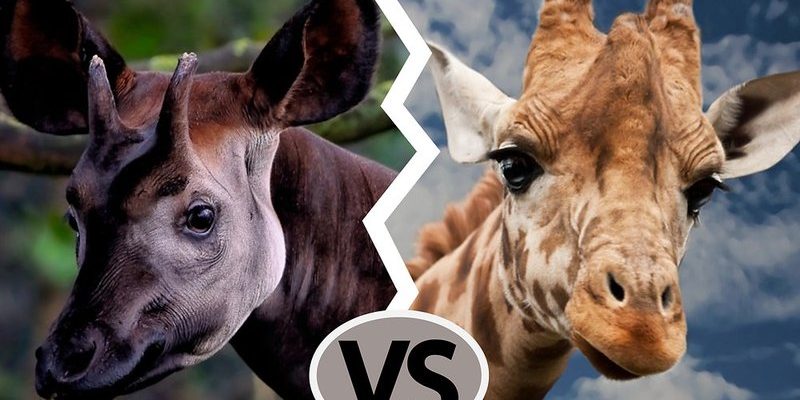![Comparing The Okapi Vs. [Similar Species]](https://gudri.com/wp-content/uploads/2025/06/Comparing_The_Okapi_Vs___Similar_Species__image_0.jpg)
It’s intriguing to explore how two members of the same family can look so different and behave in such unique ways. Both the okapi and the giraffe are part of the Giraffidae family, but they have their own quirks and lifestyles. Let’s dive deep into their similarities and differences to better understand these remarkable animals.
Physical Appearance
Both the okapi and the giraffe are captivating to look at, but they showcase very different styles. If you ever saw an okapi, you’d notice its stunning dark brown body with striking white stripes on its legs, almost like it’s wearing fashionable socks. This unique coloration helps it camouflage within the dense foliage of its forest home. The okapi averages about 4 to 5 feet tall, which is pretty short when you compare it to its taller cousin.
Giraffes, on the other hand, are the towering giants of the animal kingdom. They can reach heights of up to 18 feet! Their long necks and distinctive patchwork coats of tan and brown spots make them easily recognizable. While both animals have similar body shapes, the sheer height of a giraffe gives it an edge when it comes to reaching high leaves and branches. This adaptation is crucial for survival in the savannas where they roam.
Skin and Fur
The okapi has a velvety coat that feels quite soft, allowing it to blend in with the rich textures of the rainforest. Honestly, if you were to pet an okapi, you might be surprised by its luxurious fur! In contrast, giraffes have coarse fur that seems almost like a heavy blanket, which helps protect them from the elements. This difference in texture reflects their habitats—one prefers thick forest cover, while the other traverses open savannas.
Habitat and Range
You might be wondering where you’d find these two remarkable creatures. The okapi is exclusively found in the rainforests of the Democratic Republic of Congo. Unfortunately, this limited range makes them vulnerable to habitat loss and poaching. They thrive in the dense forest, where they can hide from predators and find the leafy greens they love to munch on.
Giraffes, on the other hand, roam the grasslands and savannas of sub-Saharan Africa. They often gather in herds, moving together to find food and avoid threats. Their habitat is expansive, which allows them to adapt to various environments. This mobility is crucial as they can migrate to areas where food is more plentiful, something the more stationary okapi can’t do as easily.
Social Behavior
In terms of social interactions, giraffes tend to be more social than okapis. Giraffes often form loose groups called “towers,” helping them keep an eye out for predators. If one giraffe spots danger, it can alert the others.
Okapis are more solitary creatures. They often prefer to go about their business alone, only coming together during mating season. This behavior reflects their need for privacy in the dense jungle, where they can find ample food while being less exposed to threats.
Dietary Habits
Both the okapi and the giraffe are herbivores, but their diets reflect the resources available in their habitats. Okapis are browsers, meaning they eat leaves, fruits, and flowers from trees and shrubs. Their long tongues help them reach delicious leaves that are out of reach for most other animals.
Giraffes are also browsers, but they mainly feast on acacia leaves which can be found in abundance in their savanna homes. Their long necks are perfectly adapted for reaching high up into trees, allowing them to access food that other animals cannot. This dietary specialization is what enables both species to thrive in their respective environments despite being related.
Feeding Techniques
When it comes to feeding techniques, both animals have unique ways to grab their favorite snacks. The okapi uses a skillful combination of its long tongue and agile movements to snatch leaves and flowers from higher branches. Their tongues, which can be up to 12 inches long, help them reach food that is otherwise inaccessible.
Giraffes, on the other hand, can effortlessly reach the highest branches thanks to their towering height. They can even bend backward to lick leaves off the branches—a quirky talent that allows them to enjoy their favorite acacia trees even more!
Conservation Status
Sadly, both the okapi and the giraffe face challenges in the wild. Okapis are currently classified as endangered due to habitat loss and poaching. Their secluded habitat makes them particularly vulnerable to human activities, making conservation efforts critical for their survival.
Giraffes are classified as vulnerable, with certain populations facing a higher risk of extinction. Habitat loss, poaching, and human-wildlife conflict have all contributed to their decline. Organizations like the Giraffe Conservation Foundation are working tirelessly to raise awareness and protect these magnificent creatures.
Conservation Efforts
Conservation efforts for both species focus on protecting their habitats, educating local communities, and supporting wildlife reserves. For the okapi, initiatives in the Congo emphasize anti-poaching efforts and habitat restoration.
For giraffes, conservationists work to establish protected areas and monitor populations. They also engage local communities to promote sustainable land use that benefits both people and wildlife. It’s a tough battle, but every little bit counts!
At first glance, the okapi and giraffe might seem like completely different creatures, but they share a fascinating connection through their lineage. While the giraffe towers over the landscape, the okapi quietly blends into the shadows of the rainforest. Both deserve our attention and protection. Understanding their differences helps us appreciate these extraordinary animals and the unique ecosystems they inhabit. So, the next time you hear about these amazing creatures, remember the rich stories behind their existence and the importance of preserving their homes.

